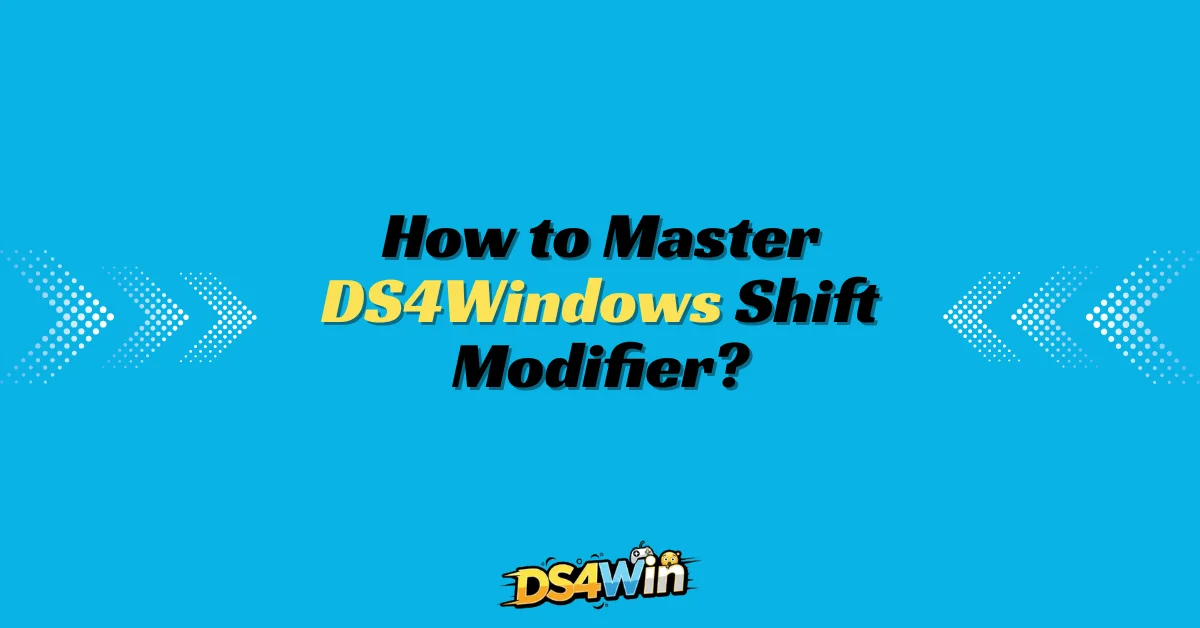How to Master DS4Windows Shift Modifier?
Your PlayStation controller holds untapped potential that DS4Windows can unlock through its Shift Modifier feature. By creating a second layer of button assignments, you gain access to twice as many commands without changing your hardware. This solution helps streamline complex games that demand numerous control options.
What is the Shift Modifier in DS4Windows?
DS4Windows is popular software that lets PC gamers use PlayStation controllers with extensive customization options. Among its most valuable features, the Shift Modifier stands out for its ability to expand your controller’s capabilities without additional hardware.
Think of the Shift Modifier like the shift key on your keyboard. On a keyboard, pressing “a” types a lowercase letter, but holding shift and pressing “a” produces an uppercase “A.” The Shift Modifier in DS4Windows works the same way with your controller buttons.
When you hold down a designated button (your “shift” button), all your other controller buttons can perform completely different functions. This essentially gives you two separate control schemes in one controller.
Why Gamers Need the Shift Modifier?
The standard PlayStation controller has about 14 buttons, which might seem plenty until you play games with dozens of commands. Modern games often require numerous inputs for:
- Character movements
- Combat actions
- Inventory management
- Map navigation
- Communication tools
- Special abilities
Without the Shift Modifier, you might find yourself pausing frequently to access menus or missing out on quick actions during critical gameplay moments. The Shift Modifier solves these problems by creating a second layer of controls that you can access on the fly.
If you’re new to DS4Windows, check out our guide on What’s the First Thing to Do After Installing DS4Windows to get started with the basics before diving into advanced features like the Shift Modifier.
Setting Up Your First Shift Modifier
Getting started with the Shift Modifier in DS4Windows takes just a few minutes. Here’s a straightforward process:
- Open DS4Windows and select your profile – Either use an existing profile or create a new one specifically for the game you’re playing.
- Choose your modifier button – Select a button that’s easy to hold while playing but not one you need to press frequently on its own. Many gamers choose L1, R1, or the Share button.
- Set up your base controls – Assign your normal functions to each button as you typically would.
- Add shifted functions – For each button you want to modify, assign a second function that activates when your modifier button is held.
- Test your setup – Make sure your new button combinations feel comfortable and intuitive during gameplay.
The best part is that you can customize this setup for each game. Your Shift Modifier might control weapon swaps in one game and spell casting in another.
DS4Windows Shift Modifier Modes Explained
DS4Windows offers three main ways to use the Shift Modifier:
1. Hold Mode
This is the most common and straightforward approach. Your shifted functions only work while actively holding down the modifier button. Once you release it, all buttons return to their normal functions.
Hold Mode works best for:
- Quick, temporary actions
- Functions you need occasionally
- Emergency commands like healing or special moves
2. Toggle Mode
With Toggle Mode, you press the modifier button once to activate the shifted layer and press it again to return to normal. This frees up your fingers since you don’t need to hold any buttons down.
Toggle Mode excels for:
- Extended periods in an alternate control scheme
- Building or crafting modes
- Sniper or precision aiming sections
3. Custom Mode
Custom Mode offers advanced options for power users. You can create complex conditions for when shift layers activate, combine multiple modifier buttons, or even set up timed shifts.
This mode helps with:
- Creating three or more control layers
- Setting up game-specific macros
- Developing accessibility options for players with limited mobility
Real-World Examples of Shift Modifier in Action
Understanding how the Shift Modifier works in practice helps illustrate its value:
| Game Genre | Base Button | Normal Function | With Modifier | Shifted Function |
| FPS Games | Square | Reload | L1 + Square | Switch Fire Mode |
| RPGs | Triangle | Use Item | R1 + Triangle | Quick Menu Access |
| Racing | X | Accelerate | L2 + X | Boost/Nitro |
| Strategy | D-pad | Unit Selection | Share + D-pad | Building Controls |
Many competitive gamers use the Shift Modifier to keep their thumbs on the joysticks while accessing additional functions through shoulder button modifiers.
Advanced Shift Modifier Techniques
Once you’re comfortable with the basics, you can explore more sophisticated setups:
Multiple Modifier Layers
DS4Windows allows you to assign different modifier buttons to create multiple layers of controls. For example:
- Normal controls (no modifier)
- Combat controls (L1 as modifier)
- Movement abilities (R1 as modifier)
- Menu shortcuts (Share as modifier)
Conditional Shifts
Set up shifts that only activate in certain game contexts or situations. For instance, your buttons might shift functions only when your character is in a vehicle or using a specific weapon.
Timed Activations
Create shifts that trigger after holding a button for a specific duration. This adds another dimension to your control options without requiring additional buttons.
Best Practices for Using Shift Modifiers
To get the most from this feature while avoiding confusion:
- Choose intuitive pairings – Group similar functions under the same modifier for easier memorization.
- Start simple – Begin with just one modifier and a few shifted buttons until the process feels natural.
- Use consistent modifiers across games – If possible, keep your modifier button the same across different games to build muscle memory.
- Document your layouts – For complex setups, keep notes on your button assignments until they become second nature.
- Test thoroughly – Spend time in a low-pressure environment testing your configuration before jumping into competitive play.
Troubleshooting Common Shift Modifier Issues
If you encounter problems with your Shift Modifier setup:
- Check for conflicting assignments – Make sure you haven’t assigned the same function to multiple buttons.
- Verify your profile is active – Confirm DS4Windows is using the correct profile for your game.
- Update DS4Windows – Older versions might have bugs affecting the Shift Modifier functionality.
- Adjust the dead zones – Sometimes button sensitivity settings can interfere with proper detection of your modifier presses.
- Restart the application – If all else fails, closing and reopening DS4Windows often resolves temporary glitches.
For more comprehensive troubleshooting, check out our guide on troubleshooting common DS4windows problems.
Why the Shift Modifier Changes Everything?
The Shift Modifier in DS4Windows represents a significant advantage for PC gamers using controllers. It bridges the gap between the limited inputs of a standard controller and the numerous commands available on keyboard and mouse setups.
By effectively doubling your available buttons, the Shift Modifier helps you play complex games more efficiently, react faster in competitive situations, and enjoy a more streamlined gaming experience without constant menu navigation.
Once you’ve mastered this powerful feature, you’ll wonder how you ever played without it. The Shift Modifier transforms a standard controller into a highly personalized gaming tool that adapts perfectly to your unique play style and preferences.







